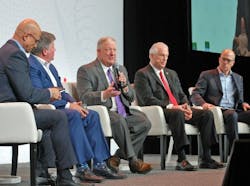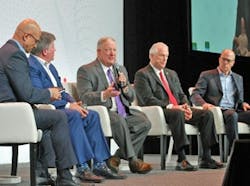Gary Hayes (center with microphone) of CenterPoint Energy, detailed future energy challenges and solutions with fellow panelists (left to right) Rob Massoudi of ABB, Joe Kava of Google, Charles McConnell of the University of Houston and Claudio Facchin of ABB this week at ABB Customer World 2019 in Houston.
Ironically, it takes a lot of energy to consider all of the world's energy problems and potential solutions, so it likely helped that "The Future of Energy" panel discussion was held over lunch at this week’s ABB Customer World in Houston.
"The global demand for safe, reliable energy is projected to grow by 25% by 2040, but even as the need becomes more critical, there are more affordable, digital technologies that can help provide it," said Rob Massoudi, group VP for digital transformation, ABB, who moderated the panel. "On the commercial and industrial sides, our relationship with energy is changing from volume to value."
Google powers up
No doubt one of the biggest users of power for digitalization is Google, which regularly consumes 2.4 gigawatts (GW) with 80% going to data centers. "Last year, we consumed more energy than San Francisco, but even though we must have abundant power, we're also committed to making certain it's renewable, comes from a diverse mixture, and is carbon neutral," explained Joe Kava, VP of global data centers, Google. "This is why we recently signed 38 renewable energy contracts with a total capacity of 3.5 GW. We upped the ante. We also stated last year that we don't just want to buy renewable power, but we also want to get all our energy 24/7 from renewable sources."
To reduce its energy load, Kava added that Google has been deploying advanced artificial intelligence (AI) to manage the loads at 18 global campuses worldwide.
Utilities go consumer
Similar to Google's experience, CenterPoint Energy reports it's also taking lessons from increasingly digitalized and consumer-driven environments. "CenterPoint's technical operations group performs about 3 billion transactions per year, so we're going from the usual operations technology (OT) approach to a more information technology (IT) model, and going from thinking of ourselves as operating an energy grid to running an 'energy Internet,' " said Gary Hayes, CIO and VP of information technology at CenterPoint Energy.
"Consumers want their lives to include energy as a service, such as seeing connections easily or viewing battery efficiencies, while others want service providers to take care of it, so they don't have to think about it."
Hayes added CenterPoint's long history as an electric utility will enable it to transition to serving today's newly empowered, digital customers. "Making the cake still requires energy and voltage, so we know that what we've done over the past 100 years can be combined with the digital component," added Hayes. "We think our history helps us understand how to orchestrate the future to give our customers the plug-and-play services they need for success."
Charles McConnell, executive director, Carbon Management and Energy Sustainability, University of Houston, added that, "Utilities are still making megawatts and getting paid, but there can be overhangs when they have too much capacity when they don't need it, or too little capacity when they do. Prices and costs are important, but the public is still best served when power is reliable."
Worldwide experiences
"As a global player, we're seeing these energy trends revolutionize industries and communities worldwide in the same ways. They're happening on different stages, but they're all hitting on the same curve, said Claudio Facchin, president of ABB's Power Grid division. "They all include the emergence of renewables, more distributed energy generation footprints, new digital consumers like Google and other changing use patterns. However, what's remained the same is that they all still need reliable power.
"The good news is that technology innovations, including ABB solutions, can support existing energy infrastructures, as well as manage the increased complexity as it comes along. This can be done with strengthened infrastructure and increased capacity, and also with micro-edge technologies, increasingly efficient battery storage, and demand-response devices and software. However, the overall solution that enables all these other solutions is collaboration by all the parties involved, including everyone from the utilities to the consumers themselves."
About the Author

Leaders relevant to this article:


